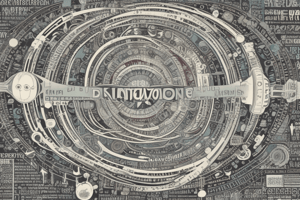Podcast
Questions and Answers
What is the primary focus of basic research?
What is the primary focus of basic research?
- To solve practical problems using existing knowledge
- To create prototypes for testing new products
- To develop new technologies for commercialization
- To increase scientific knowledge without immediate applications (correct)
Which of the following characterizes applied research?
Which of the following characterizes applied research?
- It is strictly curiosity-driven
- It uses existing knowledge to solve specific problems (correct)
- It primarily focuses on theoretical concepts
- It develops new scientific knowledge without applications in mind
What is meant by 'creative destruction' in the context of innovation?
What is meant by 'creative destruction' in the context of innovation?
- New technologies requiring the obsolescence of old firms and practices (correct)
- A method of enhancing production efficiency in established firms
- The process of gradually developing new products from existing ones
- The process of improving existing technologies without any market impact
How can innovation impact economic growth at a national level?
How can innovation impact economic growth at a national level?
What aspect distinguishes innovation from invention?
What aspect distinguishes innovation from invention?
What is the goal of experimental development in R&D activities?
What is the goal of experimental development in R&D activities?
Which innovation type specifically improves production effectiveness or efficiency?
Which innovation type specifically improves production effectiveness or efficiency?
What role do generic technologies play in the context of industries?
What role do generic technologies play in the context of industries?
Which statement best describes research and development (R&D)?
Which statement best describes research and development (R&D)?
What is the significance of including both invention and diffusion in innovation?
What is the significance of including both invention and diffusion in innovation?
What is the primary goal of radical innovation?
What is the primary goal of radical innovation?
Which type of innovation is characterized by lower cost and less use of resources?
Which type of innovation is characterized by lower cost and less use of resources?
In which model is R&D considered the primary source of innovation?
In which model is R&D considered the primary source of innovation?
How do smaller firms typically contribute to innovation?
How do smaller firms typically contribute to innovation?
What distinguishes a unicorn company?
What distinguishes a unicorn company?
What is a characteristic feature of the chain link model of innovation?
What is a characteristic feature of the chain link model of innovation?
Which type of innovation specifically targets the needs of marginalized communities?
Which type of innovation specifically targets the needs of marginalized communities?
What advantage do large firms have in the innovation process?
What advantage do large firms have in the innovation process?
Which innovation model leads to closed strategies and focuses on breakthrough R&D?
Which innovation model leads to closed strategies and focuses on breakthrough R&D?
What is the primary intent behind eco-innovation?
What is the primary intent behind eco-innovation?
Flashcards
Innovation
Innovation
A new or improved product or process that significantly differs from previous versions and is publicly available (for products) or used internally (for processes).
Invention
Invention
The act of creating something new, but it doesn't necessarily mean it's put into practice.
Technology
Technology
The practical application of scientific knowledge.
Research and Development (R&D)
Research and Development (R&D)
Signup and view all the flashcards
Basic Research
Basic Research
Signup and view all the flashcards
Applied Research
Applied Research
Signup and view all the flashcards
Experimental Development
Experimental Development
Signup and view all the flashcards
Process Innovation
Process Innovation
Signup and view all the flashcards
Creative Destruction
Creative Destruction
Signup and view all the flashcards
Innovation for Sustainable Development
Innovation for Sustainable Development
Signup and view all the flashcards
Radical Innovation
Radical Innovation
Signup and view all the flashcards
Incremental Innovation
Incremental Innovation
Signup and view all the flashcards
Social and Sustainable Innovation
Social and Sustainable Innovation
Signup and view all the flashcards
Frugal Innovation
Frugal Innovation
Signup and view all the flashcards
Green/Eco-Innovation
Green/Eco-Innovation
Signup and view all the flashcards
Inclusive Innovation
Inclusive Innovation
Signup and view all the flashcards
Grass-Root Innovation
Grass-Root Innovation
Signup and view all the flashcards
Linear Model (Science Push)
Linear Model (Science Push)
Signup and view all the flashcards
Chain Link Model
Chain Link Model
Signup and view all the flashcards
Innovation Management
Innovation Management
Signup and view all the flashcards
Study Notes
Innovation Definition and Types
- Innovation is a new or improved product/process significantly differing from previous ones, made available to users (product) or employed (process)
- Invention is creating a new way; innovation is invention plus diffusion via commercialization or public provision
- Technology arises from scientific knowledge with practical applications through innovation
- Research & Development (R&D) is systematic creative work to increase knowledge stock and use it for new applications (OECD)
R&D Activities
- Basic Research: Develops scientific knowledge without immediate applications ("curiosity driven"), usually in large firm labs & universities. Outputs are scientific papers & applied research inspiration.
- Applied Research: Uses existing knowledge to solve specific problems. Can lead to new technologies & patents.
- Experimental Development: Solves technical problems for new products/processes or improves performance. Can result in testable prototypes leading to innovation.
Innovation Implications
- Crucial for business competitiveness and growth (including startups).
- Generic technologies can create and destroy industries (steam, electricity, IT).
- Supports national economic growth via productivity enhancements.
- Drives economic diversification and structural change.
- Facilitates sustainable development.
- Creative Destruction: New technologies & organizations challenge existing systems, leading to economic renewal & higher developmental levels.
Types of Innovations
- Process Innovation: Changes product creation methods without modifying the product, improving efficiency or production volume.
- Product Innovation & Technological Trajectories: Product life cycles are shortening; frequent product replacement w/ better versions/new varieties is critical.
- Radical/Incremental Innovation:
- Radical: Doing something new (e.g., voice recognition, hybrid cars, online share trading)
- Incremental: Improving existing processes/products (e.g., Windows 7, improved phone services)
- Social & Sustainable Innovation:
- Frugal: Lower cost/resource use
- Green/Eco: Environmental protection & climate change response
- Inclusive: Social/economic opportunity for marginalized groups
- Pro-poor/Bottom of the pyramid
- Grassroots: Developed by lower-income groups
Innovation Models
- Product & Process Innovation are interconnected:
- New processes facilitate new product development (cars, bikes).
- New products enable new processes (e.g., new software).
- One firm's product innovation can be another firm's process innovation.
Linear Model (Science Push)
- Scientific advancements drive technological change.
- R&D is the origin; invention is crucial.
- Supports public investment in basic research & knowledge protection (patents).
- Often associated with "closed" innovation strategies & separation of phases, with innovations born in large corporate labs, isolated from universities.
Chain-Link Model
- A chain-link model depicts innovation as a trial-and-error process, with market testing as a key feedback source (F).
- Identifies market potential, designs/tests ideas, enters the market, with feedback loops at each stage.
- Existing knowledge (K) or research (R) is drawn upon as needed during the process. Problems may be solved using existing knowledge (K) or necessitate further research (R), with uncertain outcomes.
Innovation Management
- Small firms, especially entrepreneurial ones, are often major innovation sources, driven by flexibility, dynamism, lower bureaucracy, and lower costs, but potentially more radical innovations earlier.
- Large firms in concentrated industries can gain significant advantage from innovation, supported by financial capability, diverse portfolio, and improved scaling.
- Unicorn companies (valuation >$1B), Gazelles (rapid-growth SMEs), and Dolphins (agile science-based start-ups) represent different company types.
- The Resource-Based View: Competitive advantage stems from valuable, rare, inimitable, and non-substitutable resources. These combine into capabilities/competencies for specific tasks, with core competencies distinguishing the firm from competitors & being hard to imitate.
Studying That Suits You
Use AI to generate personalized quizzes and flashcards to suit your learning preferences.




